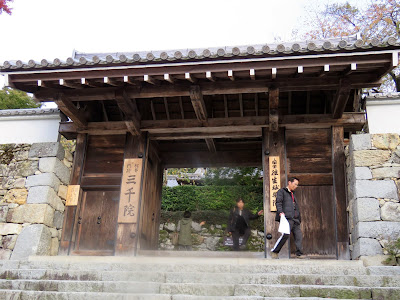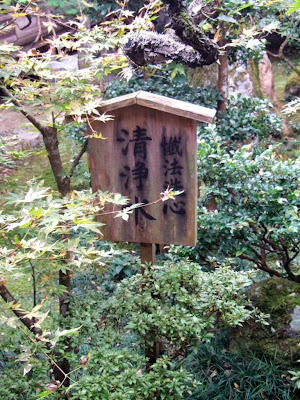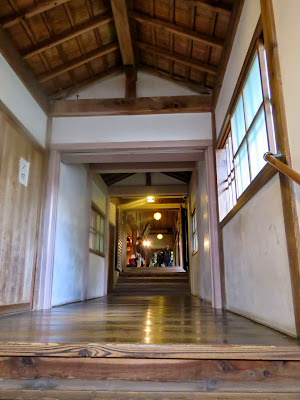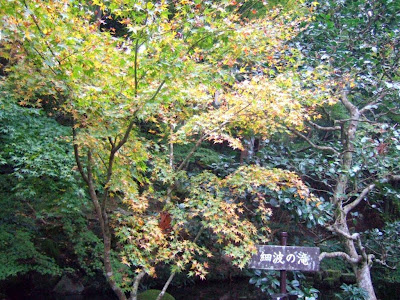
Sanzen-in also known as Askai-ji Goten, is a beautiful temple located in the little quaint river town of Ohara, north east of Kyoto. It was established in year 784 by a great Buddhist master Saicho (762-822) who 20 years later found The Tendai Sect of Japanese Buddhism. Sanzen-in when first built was a small Tendai Temple at Hiei Mountain but relocated to Ohara after Onin War (1467-77). Rev Saicho wisely applied the natural hilly landscape of Ohara and merged them into temple construction with ponds and gardens. In year 860, the temple was rebuilt by priest Joun by order of Emperor Seiwa (850-878). Sanzen-in was one of the 5 royal temples of Tendai Sect of Buddhism. It became one of the few Monzeki Temples in Kyoto that had imperial members served as an abbot commencing from 12t century when the 2nd son of Emperor Horikawa was assigned as the head priest of the temple.



There are many smaller temples with beautiful gardens in the vicinity including a soundless waterfall Otonashi as it was said that the water falling sound was always covered up the chanting of monks from the temples.



Sanzen-in has a relatively simple front gate but internally, it has vast temple grounds. Variety of buildings and gardens are linked to each other by wooden corridors and wooded walkways.


The outside scenery when looking from inside, is as if a framed up picture.



The site provides a tranquil grounds for lush nature lovers.





The first hall we encountered was Kyakuden Guest Hall which originally was the abbot's living quarter. Many treasures were displayed in its Tatami Rooms including painted screen Byobu and decorative Fusuma sliding panels.



Kyokuden Hall that linked up with main shrine hall Shinden by corridor, was opened out to Shuheki-en Garden which literally means Garden that gathers green. It was one of the two beautiful gardens that set around a large pond



Shuhekien Garden with landscaped hills and pond is indeed a photogenic garden.



A place that is so rich in enchanting natures.






The famous Yusei-en garden has a pond that filled with colorful carps.


Yusei-en means Pure Pleasure Garden. It is famous for its moss, maple, azaleas and cryptomeria that covered up the area near a pond.





Tables setting outside the main hall at Kokedera Moss Garden is the place for people to experience copying a Buddhist scripture. Seated cross-leg in a tranquil room, under a scenic circumstance, using brush and ink to mindfully trace over the Japanese script, word by word. This is one of the Buddhist activities and practices to control one's wild thought and to train one's mind into concentration, calmness and peacefulness.



Sutra Copying activity is quite a common practice in many Mahayana Buddhist Temples around the world and most of them are free of charge but in Japan, participants are required to pay 3000 yen for it and reservation must make few days prior to it.


Shinden Main Temple which is also named as Paradise of Ultimate Bliss, lies in Yusei Moss Garden with maple and cedar trees surrounded. Its ceiling shaped out as if a base of a boat is known as Funazoko-kei in Japan. It was decorated with mandalas painted by Rev. Enshin (942-1017). The hall enshrines an image of Amitabha Buddha flanked by Bodhisattva Kannon and deity Fudo Myoo by his two sides.



There are hundreds of varieties of moss in Yusei Garden.


The interesting stone images placing in Moss Garden


Hall of Ojo Gokuraku-in which means Hall of Rebirth in Paradise is located at the middle of Moss Garden. It was the oldest building at site that built in year 985 by Priest Enshin (942-1017) and restored in 1143. The building enshrines a gilded image of Amitabha Buddha measured 2.3 meters in height, flanked by Bodhisattva Kannon and Seishi on both sides, in kneeling posture. It is the most valuable treasure in Sanzen-ji Temple.



The artifacts at ground including a pillar written there offered by the surrounding plants, which really stroked me hard. It never exists in my mind that flora also can do a part in Dana (contribution). No wonder, the plants grow so well in the surroundings. Giving benefits others as well as your own self.



Firing colors of foliage at site.







Stayed within the serene ground, ambled at a slow pace and joyfully explored into the hidden beauty of the deep nature, brought me peacefulness and relaxation.


A tranquil path that leads to the forested area.



Huge and tall cedar trees and maple were the factors that created such a lovely and soothing environment for the little Shrine at Temple grounds



There are several recent buildings located at the back of temple grounds. Many buildings that were originally reconstructed from Shishiden ceremonial Hall of Kyoto Imperial Palace within years 1596-1615, were all restored in 1920s, including the hall for Immutable Lord Deity Acalanatha.



The image of Yakushi Nyorai Medicine Buddha enshrined in the hall, was believed to be most probably carved by Master Saiho himself.


The striking Kannon Hall was also one of the building that restored in 1920s.


Strolling along the walking path, we found this little water fall hidden under a thick wood.



Almost all corners at temple grounds were either partially highlighted with attractive colors or fully shaded into brilliant hue in fall.






The little hut was found standing alone at the far end of the compound. It enshrines with an old Buddha stone image.



The stone image of Amitabha Buddha dated from Kamakura era (1185-1333)



A stone scripts written pagoda, a stone lamp and an old plant of a rare red plum tree, all have gone through their past, done their part but continued surviving at the corner of this paradise land.



Sanzen-in was winded up by stone walls with several gates opened to the direction of Rogawa River.



No comments:
Post a Comment